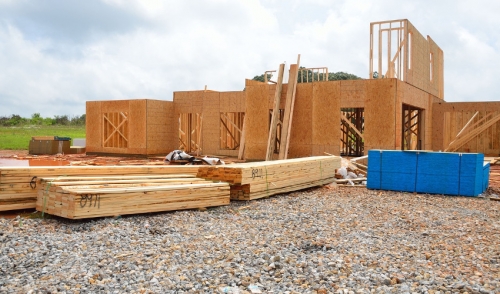
Pushing The Framing Envelope
Being able to walk between two studs without bumping your toolbelt against the wall frame or having to turn your torso to fit through the space is a simple pleasure that could win over the trades to see the broader benefits of pushing the envelope.
Beechen & Dill, a Burr Ridge, Ill., builder and the sister company of Summit Signature Homes, is trying to do just that. Recently the company held an open house at a 2,880-square-foot project to demonstrate advanced framing practices. The floors and walls were left open so that visitors could see wall sections with 2x6 studs spaced 24 inches on center instead of 2x4s spaced 16 inches on center. Looking up from the basement, we saw deep I-joists, also 24 inches on center, with 7/8 -inch decking above.
Our tour leader, a consultant from APA-The Engineered Wood Association, explained the energy efficiencies to be gained by being able to stuff more insulation into deeper wall cavities, and the benefits of constructing a stiffer floor with less material and labor compared with conventional framing. On the tour, two visitors from USG shared that the depth of the joists combined with the structural transfer to 24-inch spacing can also dissipate the amplitude and frequency of sound waves. In other words, the house will be quieter because less noise is carried between floors.
The open-house idea had its roots a couple of years ago when Ed Kubiak, Beechen & Dill’s director of construction, was looking for a way to build wall header systems to accommodate insulation instead of using blocks of wood above his doors and windows. He went to an APA seminar about advanced framing at the International Builders’ Show, met the presenters afterward, and they kept in contact. Eventually the connection turned into Beechen & Dill’s first attempt at advanced framing, and then this open house.
So why go through all the trouble? Kubiak says it was a good opportunity to grow and stay ahead of the market. The builder is starting a new section of a community, and the open house, which was promoted on social media, was a good way to give it visibility. Also, Beechen & Dill builds in several Chicago suburbs, so when code inspectors came to the open house and saw that the company was working with a national association, the builder gained credibility. “They see we’re doing this the right way,” Kubiak says, “taking framing to the next level and not just trying to do the minimum.”
Subcontractors were coveted as open-house guests because if the trades understand some of the downstream benefits of advanced framing for them, maybe Beechen & Dill will become their builder of choice. Already the electricians have remarked positively to Kubiak about having more room to work within the wall frames and fewer studs to drill through for running conduit.
But not everyone will be a convert. An architect on the tour told me that his network of builders wouldn’t go for advanced framing. “He’s right,” Kubiak says. “The industry fights change sometimes, but somewhere along the line someone has to push the envelope. We’ll try to push through.”
